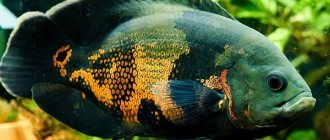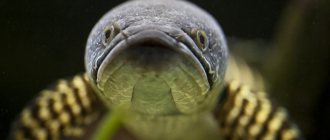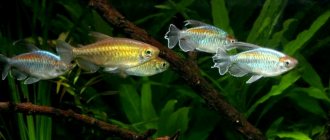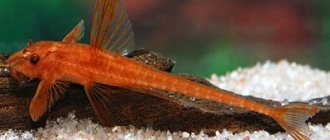Clarius (Clarias) is a genus of freshwater catfish, aggressive, large and beautiful predators that can breathe atmospheric oxygen and, due to this, if necessary, crawl from reservoir to reservoir. They inhabit the waters of Africa, southwest and southeast Asia. Sometimes kept in aquariums as ornamental fish.
Distinctive external features: • acne-like body; • there are no scales and small bones; • 8 antennae (2 - near the nostrils, 2 - on the upper jaw and 4 - on the lower jaw); • long dorsal fin, which extends from the back of the head to the caudal fin; • long subcaudal fin; • There are tree-like accessory gill organs on the 2nd and 4th gill arches.
K. Spotted
General description and habitat
The Clarias catfish genus belongs to the Clariaceae family. Some experts believe that the correct name is not Clarius, but Clarias. Therefore, the spelling varies in different sources.
Clarius is widespread in Africa, Southeast Asia, and the countries of the Middle East, where they settle in the biotopes of rivers, lakes, streams, and swamps.
In the mid-20th century, catfish were brought to the USA and Europe, and in the 70s. African catfish have become the most desirable for aquarium keeping.
The Clarius catfish has a large flattened head and an eel-like body, along the entire length of which there is a dorsal fin numbering from 62 to 77 rays, the anal fin is slightly shorter - 45-63 rays. The fins do not extend into the tail. The pectoral fins are equipped with powerful spines with jagged edges, which catfish use when meeting an enemy.
Clarius skin is very dense, without scales. There are 4 pairs of whiskers on the head, used by catfish as radars to search for food. Two pairs point up, two down, and two on each side.
An interesting feature of this species is the ability to distinguish colors. The natural body color is predominantly gray-brown; albino catfish are also found. Individuals with spotted colors are produced using the selective selection method.
Look how beautiful it looks:
Another feature of these fish is the ability to breathe atmospheric air. The epibranchial respiratory organ, which is essentially a real lung, will allow them to cover distances on wet grass of up to 5 km. For this ability, Clarius received the name “walking catfish”.
In their natural habitat, clarius grows up to 1 meter, in an artificially created biosystem up to 25-70 cm.
Externally, the fish are similar to sacbranch catfish (Heteropneustes fossilis). But they have a number of significant differences:
- the fin of the sacbranch catfish is short;
- respiratory organ - bags.
These factors draw the line between the two families.
Diseases
- Skin damage from fights and hooligan behavior causes mycoses. They appear as light threads at the affected areas. Self-treatment can lead to the death of fish. The help of an ichthyopathologist is needed.
- Ulcers. And also from scratches. A solution of potassium permanganate helps. 0.2 g of crystalline substance per 10 liters of water in an aquarium with a complete replacement within 10–12 hours. It is more effective to place 0.5 g of the drug per 10 liters of soft water (up to 4 °C) in the prepared solution for 15–20 minutes.
- Ichthyophthyriosis. Caused by ciliates brought in from outside. They are bred by adding potassium permanganate and copper sulfate to the aquarium. If it doesn’t help, use Bicillin 5.
- Keeping it in a cramped container or without aeration risks nitrate poisoning. Expressed by lack of activity, spots on the fins, ulcers.
Varieties
All representatives of the clariaceae family have an elongated body shape, 4 pairs of whiskers and are distinguished by omnivorous and aggressive behavior.
Clarium catfish are usually divided into several subspecies:
- Angolan or spotted Clarias (C. Angolensis). Body length is 20-35 cm. The belly color is white, the rest of the body can be of different colors: olive, gray, gray-brown. This species sometimes gives birth to albinos: catfish with a white body and red eyes.
- Nile Clarius or Sharmouth (C. anguillaris). Its other known names are African or marbled clary catfish. Able to change skin color depending on the color of water. The most common color is marbled with greenish and gray shades. In the presence of a stranger (a catfish of the same species that has swum into its territory), the marbled catfish produces an electrical signal in order to scare away the uninvited guest. These are very large individuals, growing up to 1.7 meters in nature and up to 60 cm in an aquarium.
- Eel clarium (C. batrachus). This species lives in Asia. In the natural environment it grows up to 50 cm, in an aquarium up to 35. The color is very diverse: white, brown, gray, white-black, golden. Can be plain or spotted. Albinos are also found. Males of this subspecies have spots on the dorsal fin; females do not. This is the hardiest species of Clarias and is very aggressive. The fish is not for a community aquarium, as it will eat other inhabitants that fit in its mouth.
- Flathead catfish (C. platycephalus). In aquariums, this representative of clariids grows up to 40 cm. In the wild, the color is gray-brown; for home breeding, albino and piebald individuals are more often chosen.
All varieties are kept as ornamental fish.
Breeding
In the natural environment, females can lay up to 1000 eggs, from which, after about 1-1.5 days, fry appear.
Breeding Clarius catfish at home is difficult for several reasons:
- Large capacity aquariums are required for spawning.
- Sexual dimorphism in fish is practically not expressed.
- The male does not respond to every female.
Nevertheless, the technology for breeding catfish at home exists.
Several adult individuals are placed in a specially prepared container of the appropriate size. There they remain until the pair is formed. After its formation, the remaining fish are deposited. Upon completion of spawning, both the male and female are removed.
The aggressive predatory character manifests itself in Clarius at a very early age. The fry are greedy for any food and try to swallow everything that catches their eye. Feeding is carried out several times a day in small portions.
Growing fish are periodically sorted to prevent larger ones from eating their smaller counterparts.
Features of character and behavior
Clarius catfish likes to be alone, rarely, but can create a pair, and then they spend all their time together.
These are active and strong fish. Most of the time they stay near the bottom; they like to dig the soil, lie on the bottom, raising their upper body. Unlike other species, their activity does not depend on the time of day. The pet gets used to the owner and allows itself to be petted, and over time it learns to eat from hands.
Only large fish that can fend for themselves are suitable as neighbors:
- some types of barbs;
- cichlazomas;
- armored catfish;
- paku.
Clarius will eat small fish without hesitation.
Not to be confused with the sacbranch!
These representatives of clariids are sometimes confused with sacbranch catfishes. Possibly due to the spines on the pectoral fins. However, they differ from each other:
- The dorsal fin of the former is long, and that of the latter is short.
- Both can breathe atmospheric air, but the first uses the epibranchial organ for this, and the second uses special bags on both sides of the back.
Care and maintenance
Clarius catfish is a large aquarium pet, the care of which is quite labor-intensive.
Firstly, you need an aquarium of 200-300 liters with a cover glass or lid. Clarius grows quickly and may outgrow his house. Under unfavorable conditions, the catfish may escape from the tank. In this case, it should not be handled with bare hands. With its thorns, a pet can hurt a person, and the mucus on the thorns, if it gets on the skin, can cause irritation.
A prerequisite is that the distance between the surface of the water and the lid is at least 5 cm, so that there is no interference if the fish decides to breathe above the water.
Catfish loves running water, so a powerful filter is a must. Moreover, there is a lot of waste from Clarius. It does not make high demands on water parameters, but it is better if the acidity is at the level of 5-8 units, the hardness is average and the temperature is in the range of 20-30ºC.
Stones, driftwood, and grottoes are placed in the aquarium as shelter. But they must be securely fastened, otherwise it will not be difficult for Clarius to move them or turn them over.
In a species aquarium, they do without plants or securely strengthen them and plant them in pots, since Clarius is a big fan of loosening the soil and will quickly damage them.
It is better to use coarse sand and small smooth pebbles as a substrate. It is better to avoid coarse soil: when Clarius digs the substrate, it can scatter it around the aquarium and damage the glass.
Compatibility
Clarius albino
It is worth admitting that Clarius has a disgusting character. Anything smaller will be swallowed. Larger fish will become targets for constant attacks and aggression. The best solution is a species aquarium. Catfish feel great alone and get along with each other in a pair, provided that one develops.
If you still want to have neighbors, you can try adding astronotus, shark barb, paca, and thoracatum.
Diet and feeding regime
Clarius loves to eat and is constantly hungry. Catfish eat everything without exception. This can be any type of food: dry, tableted, frozen, fresh.
Main products for Clarius:
- bloodworm;
- tubifex;
- squid (pieces);
- beef heart;
- chicken liver;
- fish.
Vegetable fertilizer is also required. Pork is completely excluded from the menu. This product is poorly digestible and leads to obesity.
The catfish eats the main part of its food at twilight and at night. It uses its whiskers to detect food.
Benefits of claria fish
The value of soma claria lies in its beneficial effects on all systems of the body. When consumed in moderation, fish:
- normalizes the functioning of the nervous system and helps cope with stress;
- improves cellular metabolism;
- strengthens blood vessels and prevents the development of atherosclerosis;
- protects the heart from illnesses;
- Helps maintain tone and energy;
- increases immunity and resistance to viral diseases;
- strengthens bones and joints due to the high calcium content;
- has a beneficial effect on mental and physical activity;
- improves the condition of hair and nails.
We recommend reading: Cheese (peled): what kind of fish, benefits and harm to the body
Claria fish can be consumed to prevent cancer and strokes. African catfish fillet prevents the development of osteoporosis.
Clarium fish normalizes blood sugar levels in diabetes
Photo of Clarius catfish
Reproduction
The technology for producing offspring of African clariid catfish under artificial conditions has been developed in some countries of the world, for example, Israel, Germany, Egypt. But the technology is under patents and has not been published in detail in the public domain.
In the CIS countries this technology has not yet been fully developed. Accordingly, all planting material is brought from foreign countries, which is why the cost of commercial products increases by 15%. Today, one African catfish fry weighing 10 grams costs 50 cents or 1 Belarusian ruble on the market.
Broodstock
Producers of African catfish are raised separately from commercial young stock. To form a broodstock, the best fish are selected, after which they create the most comfortable living conditions for them and feed them well.
Clarid catfish are capable of spawning every month if the queens are stimulated. The eggs obtained from the queens are artificially fertilized with male sperm and then placed in aquarium-type incubators. After the fry have grown a little, they are transferred from the incubator to the pools. This technology for breeding sharmut is typical for large fish farms.
Obtaining fertilized eggs when breeding catfish on a personal plot is a troublesome task. Because of this, many summer residents who raise African catfish simply buy caviar from fish farms.
When does spawning occur?
Successful maturation of eggs will ensure that the females are kept in water with a temperature of at least 25 degrees until spawning. Ovulation completely takes place 12 hours after the injection of the pituitary gland. African catfish are called nervous fish, which is why fish farmers have to euthanize females to obtain eggs without problems. An anesthetic drug is injected into the fish, most often “Propiscin”.
The eggs are obtained separately from each female. The norm is when the mass of caviar is at least 20% of the weight of a particular fish. After the procedure, females are placed in a KMnO4 solution for 1 hour. The drug is diluted at the rate of 0.5 grams per 100 liters of water.
Receiving fertilized eggs
After receiving the eggs, the fish farmer divides them into three parts, without mixing the eggs of different females. The weight of each serving reaches about 300 grams. Next, take 3 ml of milk. Efficiency will be higher when taking milk from different males - this helps stimulate the fertilization process. So, it is advisable to take 1 ml of milk from three males. Milk and caviar are dipped into water and mixed well for 5 minutes.
Growing stages
The first stage is 20-25 days. It occurs when the African catfish begins to breathe atmospheric air. During this period, about 100 individual larvae are planted per 1 liter of water. The water is gradually saturated with oxygen, which helps to establish exchange in the pool.
The larvae's diet at this moment consists of tubifex or decapsulated brine shrimp. After 7 days, starter feed is gradually introduced into the diet. They adhere to lighting requirements - it should be dim or twilight. Due to the fact that the larvae are prone to cannibalism, at the end of the first stage, out of 100 neglected individuals, about 25-50 catfish fry will survive.
The second stage is 35 days. Initially, the fish farmer fills the pool with sorted larvae, the number of which is about 300-500 mg. Sorting of larvae is carried out by dividing them into two parts: small and larger. Catfish fry are added taking into account the individual weight of the fish and the volume of the pool. The fry must be fed three times a day, the amount of food is about 5% of the weight of the fish.
The third stage lasts several months. During this period, the weight of the fish is 130-200 grams. The growth rate of the fry depends on the stocking density. For a pool with a volume of 5,000 liters, the planting density is 2.5 pieces per 1 liter. The water temperature should be about 27 degrees. At this stage, the fry are given “floating” food. The feeding process is carried out manually or automatically. The water is changed every two hours.
Short story
Ancistrus are a very popular aquarium fish, known since the early 1900s, that have earned a reputation as champion algae killers.
Unfortunately, both before and now there is confusion in the identification of species of the genus Ancistrus. The situation is further complicated by hobbyist aquarists who give different, speculative scientific names to almost every imported species. The most common among them are: A. cirrhosus, A. temminicki and A. dolichopterus. Although most wild specimens are extremely difficult to assign to a specific species, the situation has improved slightly in recent years.
Ancistrus cf. cirrhosus was for a long time known simply as Ancistrus sp. (3). This is the most common and accessible of the ancistrus, coming to the market from fish farms in Southeast Asia and Florida. Its specific characteristics have not been determined, so there is still an opinion that it is a hybrid. However, this is doubtful because the species has been bred for a long time without any variation, and specimens found in Europe, Australia and the United States appear to be the same species. Breeding practices have led to the emergence of albino (A. sp. 4), veiled (A. sp. 5) and even albino veiled forms.
Ancistrus cf. cirrhosus (Ancistrus sp. (3)) with juveniles (ill. www.istellas.gr)
Ancistrus triradiatus (aka LDA 72) is most often exported in the wild. Representatives of this species are caught in large quantities near the city of Villavicencio, Colombia. They inhabit waters at the base of mountains and can withstand relatively low temperatures (down to 22 °C). These catfish prefer fast water with a high oxygen content, but adapt to other conditions.
Ancistrus triradiatus (LDA 72) (ill. dfcdfc69; alquimistadeacuarios.com/foro/viewtopic.jpg?t=50031)
True specimens of Ancistrus dolichopterus (aka L183) are supplied from Rio Negro, Manaus. These attractive blackwater inhabitants require soft, warm water.
Spawning
It is necessary to create comfortable conditions for spawning fish. The water temperature of a shallow, standing or low-flowing reservoir should be 20 - 22 degrees. During this period, it is necessary to provide the catfish with enhanced nutrition. Sufficient quantities of small fish are added to the spawning pond.
In the period before spawning, in early spring, males and females must be seated, otherwise, as the water temperature rises, their activity also increases, often causing injury to both sexes.
For spawning, artificial nests are made from the aerial roots of willow. They are installed two to three meters from the shore, after which the pond is filled with water to a height of up to a meter. Males and females are released into the pond equally. For catfish spawning, high water mineralization is important, up to 1.7%. The fertility of catfish is quite high: 10-18 thousand eggs per kilogram of live weight. The incubation period is 80-82 hours, the main thing is to protect the eggs from direct sunlight.
Interesting Facts
- Clarias catfish generates electricity with an organ specially designed for this purpose. Using electrical discharges, this predator communicates with relatives.
- During sleep, the catfish stands strictly vertically - on its tail or with its face down.
- Clarias quickly gets used to his owner and allows himself to be petted.
- The skin of the fish produces a protective mucus that has healing properties. It quickly heals any wounds.
- Clarius meat is considered a healthy dietary product. It does not have an unpleasant specific fishy smell, small bones or fat, and contains a huge amount of amino acids and vitamins.











